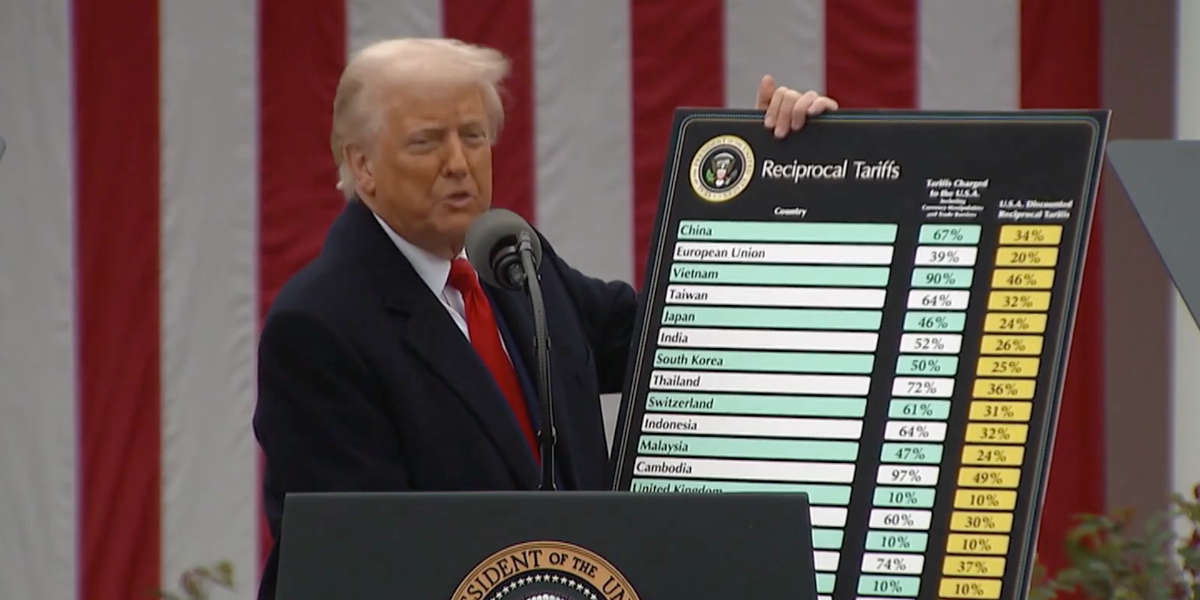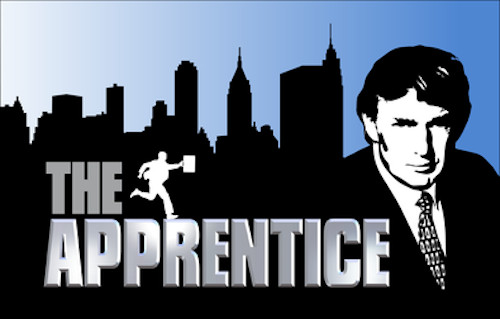En la imagen
Trump presented his ‘reciprocal tariffs’ during the so-called ’Liberation Day,’ April 2, 2025 [White House]
Throughout his career, Donald Trump has worn many hats; politician, businessman, and even, some might argue, actor. While his reputation as a businessman was built in the private sector, he has increasingly applied that mindset to politics, especially since his entry into the political arena in 2016. Now, in 2025, Trump has returned, seemingly more of a businessman than ever, running what some might call his biggest venture yet: the United States of America.
During his first term, Trump made it clear that his unique personality would shape his approach to governing. This time, however, he appears even more unabashed in treating politics like business, leading the nation as if it were his own company competing on the global stage. His decisions and strategies often reflect a commercial mindset, one that raises serious concerns not just for Americans, but for the rest of the world.
The backstory of a businessman
It seems appropriate to begin by talking about Trump’s lived experiences in the business world. He was born in an accommodated and wealthy family in New York; his father, Fred Trump, ran a real estate company that had an extensive portfolio of residential housing projects in the New York City boroughs. When Trump took over in 1971, he shifted the family business from residential units in Brooklyn and Queens to fancy Manhattan projects.
Since then, Trump expanded the family business exponentially with the opening of casinos, hotels, golf courses and condominiums all over the country. However, not everything was a success: some of his businesses faced several bankruptcies, and were unable to pay debts back to banks, investors and stock owners. Regarding this situation, Trump declared back in 2011 that "I've used the laws of this country to pare debt. ... We'll have the company. We'll throw it into a chapter. We'll negotiate with the banks. We'll make a fantastic deal. You know, it’s like on ‘The Apprentice.’ It’s not personal. It’s just business.” This provides the perfect proof of how everything revolves around business for him; he can make deals even out of heavy debts, and he is certainly not ashamed of it.
The conclusion to be drawn is that business, whether in positive or negative terms, is part of Trump’s lifestyle. He has acquired the experience to thrive through that arena, and it is not really shocking that he applies such mindset in all facets of his life, including politics, or even reality shows, like ‘The Apprentice,’ which he hosted back in 2004.
Trump’s first term
During his first term, Trump already proved that his business-making style would be present, at least to some extent, in the running of the American nation. Some decisions taken between 2016 and 2020 showed off this particular characteristic, for example when he retrieved the United States from the Paris Climate Agreement.
In 2015, under Barack Obama’s presidency, the US signed and ratified such Agreement, agreeing to reduce greenhouse gas emissions through climate plans, as well as providing financial support to developing countries. The economic and industrial implications for the US weren’t precisely in line with Trump’s financial plans for the country. In turn, the Paris Climate Agreement could imply higher costs for industries in order to reduce emissions and adopt cleaner technologies, as well as potential job losses in fossil fuel sectors like coal, oil, and gas. These plausible negative consequences led him to retrieving America out of the deal once he took office in 2017, even though the official withdrawal did not take place until 2020. The economic implications of this deal were certainly not worth it for Trump, as he declared “it disadvantages the United Statesto the exclusive benefit of other countries, leaving American workers, who I love, and taxpayers to absorb the cost in terms of lost jobs, lower wages, shuttered factories, and vastly diminished economic production.”
Trump took a similar approach in his renegotiation of NAFTA back in 2017. He had long criticised the original 1994 agreement for what he considered “encouraging" companies to outsource manufacturing to Mexico, leading to factory closures and job losses in the US, particularly in the auto and manufacturing sectors. In 2017, he initiated a full renegotiation of the deal, arguing that NAFTA had failed American workers and allowed trade partners to take advantage of the U.S. The resulting United States-Mexico-Canada Agreement (USMCA), signed in 2018 and enacted in 2020, aimed to correct these imbalances. It included stricter rules to ensure more manufacturing stayed within North America and provisions to discourage companies from relocating jobs to countries with lower labor costs. Trump sought to apply his economic plan to revive U.S. industry, by protecting domestic jobs, and reducing the trade deficit. The USMCA became a key part of his narrative of reclaiming economic sovereignty and renegotiating deals that, in his view, had hollowed out the American middle class.
Nowhere was Trump’s CEO-style diplomacy more visible than in his handling of North Korea back in 2017. Rather than relying on decades of careful, multilateral negotiations, he took the bold step of restarting direct talks with Kim Jong-un, betting that a personal relationship could succeed where traditional diplomacy had stalled. In true Trump fashion, he treated the situation like a high-stakes business deal, accompanied with dramatic photo session, handshake summits, and bold promises. He became the first sitting US president to meet face-to-face with a North Korean leader, hoping to strike a deal on denuclearization. While the talks didn’t lead to any concrete agreements and North Korea continued developing its nuclear weapons program, Trump managed to shift the tone of the relationship, at least temporarily. This was the perfect example of a pure-Trump style: direct, disruptive, and always focused on making the deal.
An (expected?) comeback: The second term
Since his defeat in the 2020 elections, Trump proclaimed that he would return to the White House in the next term, which he did. Retired at his ‘Floridian White House’, Mar-a-Lago, Trump pulled the strings and prepared the stage alongside its national and international allies for his comeback in 2024. In an agitated election campaign, Trump faced America’s Democrat Vice President Kamala Harris, who aimed to succeed President Biden and avoid Trump’s return. However, Trump became America’s 47th President and made his return to the White House, more emboldened than ever.
Many of the ideas Trump flirted with during his first presidency are now back but, this time, they seem more intentional. Back then, some of his decisions seemed chaotic or improvised, like spontaneous tweets that turned into policy. Now, he’s applying the same business-first mindset, but in a much more structured and open way. There’s less hesitation, fewer internal obstacles, and a team around him that seems to fully support his vision. He no longer pretends to play by the rules of traditional diplomacy, but instead, he’s doubling down on the idea that America should always get something out of every deal; otherwise, it is not worth engaging. Itseems as if Trump had taken the lessons of his first term and turned them into a blueprint, one where foreign policy is just another business opportunity.
Trump’s early moves in his second term say a lot about what matters to him: loyalty and image. Appointing Marco Rubio as Secretary of State, for example, was not just about diplomacy; it was a message instead. Rubio is Latino, a high-profile Republican, and someone who knows how to play both the political and media game. That choice seems less about foreign policy experience, but more about branding: showing strength in Latin America, appealing to Hispanic voters at home, and surrounding himself with people who won’t challenge his approach. Across the board, Trump’s picks seem to follow the same logic of rewarding loyalty, building the brand, and keeping control.
One of the most headline-grabbing (and now ironic) moves floated during the campaign was Trump’s idea that Elon Musk could lead the Department of Government Efficiency. At the time, it seemed appropriate, a reflection of Trump’s preference for disruptive figures who mirror his own outsider status. Musk, after all, is no public servant but a famously unpredictable entrepreneur known for cutting costs, challenging norms, and courting controversy on platforms like Twitter and in his companies like Tesla and SpaceX. The idea of him ‘trimming the fat’ in Washington fit neatly with Trump’s recurring pitch to run the government like a business; lean, confrontational, and focused on optics over process. However, recent arguments between Trump and Musk have cast doubt on this alliance. Musk has left the government, not without giving one last mediatic show, and Trump, never one to tolerate disloyalty, has fired back in kind. What once looked like a mutual admiration alliance now seems more like a brief flirtation between two egos too big to share the same stage.


